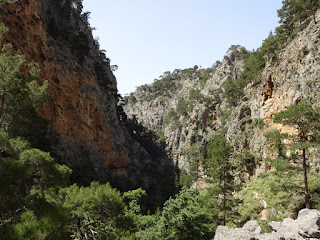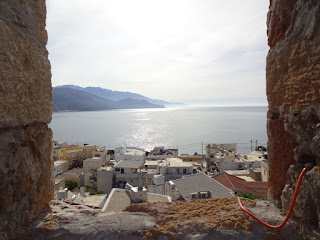An unexpectedly local breakfast, and some interesting water features were plus points today, somewhat offset by having to retrace my steps at one point due to being unable to find a viable path.
Camping in sheep country, in which many of the sheep have bells around their necks, meant that periodically in the night the noise of jangling bells came close to my tent before receding. It seems that at least some sheep graze at night and sleep under a shady tree during the day. Not a bad idea with their woolly coats.
After decamping and passing a nearby church, I walked a few kilometres down into Kallikratis. Shadows cast by the low morning sun, picked out in high contrast the detail of the trees, houses and plots of land in the village, against a backdrop of stony mountains. However it did not look like there was much in the village, so I was very pleased to find at 7:10 am in the morning an open cafe. I ordered a Greek coffee, and the proprietor (an unshaven grey haired man with a moustache) said "feta?", to which I said yes. So I had a breakfast of feta cheese, dressed with olive oil and some bread. The feta was a fresh, soft and crumbly variety and the proprietor indicated it came from the two goats in the small field opposite which he proceeded to feed. As I sat eating my cheese the occasional battered pick up passed by with a plastic churn of milk, white or brown, either from freshly milked goats or sheep as there were no cows in the area. A flock of sheep gathered on the road nearby, two of the sheep were having a head butting competition. On a gate being opened the well trained sheep went through it, I saw no shepherd or sheepdog organising them. Whether it was for milking or feeding I don't know.
Leaving Kallikratis I followed the E4 up a hill, through one of the many Cretan fences, and down the other side onto the road to Asi Gonia. To reach the bottom of a steep mountainside, the road had numerous hairpin bends. It was possible to cut off some of the loops on what the map claimed to be paths, but it was more enjoyable walking down the road admiring the view than looking down on every step to carefully place my feet among the rocks and thorn bushes on a "path". At first I thought I was going the wrong way as the sea was in the wrong place, but then I realized I was looking at the sea to the north of Crete and not the Libyan sea to the south which I had been walking beside recently.
Asi Gonia also had an open cafe where I had a Coke and cake before following my GPS route along a narrow road which became a gravel track. After a few kilometres the GPS indicated that I should head downhill to join the Asi Gonia to Argiroupoli road. I plunged through an overgrown olive grove to where I thought it should be, and after trying a few routes, and then having to climb back uphill I spotted two red stripes painted on a rock, similar to those used to mark the E4 elsewhere. First I had to negotiate the rebar fence, which seem to be everywhere in Crete. Then I had to try and find where the trail went. I found one or two of the red waymarks but not enough to work out where the path was then meant to go. My best guess was along the base of a ravine, but it was too overgrown for me to make any progress. So I was forced to return to the gravel track. To reach it I scrambled up some rocks on a steep slope, not so easy with a rucksack, and disassembled (and then reassembled) a bit of fence, not nice. Then it was a lengthy walk back to Asi Gonia before following the road route to Argiroupoli.
I marched along the road, down a steep sided valley, pretty quickly and arrived at the bottom of the hill on which Argiroupoli is built. On climbing the hill I passed coach parties of tourists. There is a natural spring which a string of restaurants have used to good effect to create water features for their customers who sit under trees, cooled by the water, eating trout. The trout seemed to be kept alive in sections of the water feature so you could be really sure of having fresh fish.
I struggled up the hill to the village, walked past some tourist type shops and a second or third century mosaic (needing a bit of a clean) to my room for tonight in Maria's rooms. Unhelpfully it does not say this on the sign outside but an older man, who spoke little English, assured me the rooms were indeed Maria's and took my passport details.
Later it was grilled vegetables and souvlaki in a restaurant with a goat statue spouting water.
I walked 29.9 kilometres including my effort to find the path with a 600 metre total ascent, if I had stuck to the road after Asi Gonia, I would have walked only 24.1 kilometres with a 390 metre total ascent.
Camping in sheep country, in which many of the sheep have bells around their necks, meant that periodically in the night the noise of jangling bells came close to my tent before receding. It seems that at least some sheep graze at night and sleep under a shady tree during the day. Not a bad idea with their woolly coats.
After decamping and passing a nearby church, I walked a few kilometres down into Kallikratis. Shadows cast by the low morning sun, picked out in high contrast the detail of the trees, houses and plots of land in the village, against a backdrop of stony mountains. However it did not look like there was much in the village, so I was very pleased to find at 7:10 am in the morning an open cafe. I ordered a Greek coffee, and the proprietor (an unshaven grey haired man with a moustache) said "feta?", to which I said yes. So I had a breakfast of feta cheese, dressed with olive oil and some bread. The feta was a fresh, soft and crumbly variety and the proprietor indicated it came from the two goats in the small field opposite which he proceeded to feed. As I sat eating my cheese the occasional battered pick up passed by with a plastic churn of milk, white or brown, either from freshly milked goats or sheep as there were no cows in the area. A flock of sheep gathered on the road nearby, two of the sheep were having a head butting competition. On a gate being opened the well trained sheep went through it, I saw no shepherd or sheepdog organising them. Whether it was for milking or feeding I don't know.
Leaving Kallikratis I followed the E4 up a hill, through one of the many Cretan fences, and down the other side onto the road to Asi Gonia. To reach the bottom of a steep mountainside, the road had numerous hairpin bends. It was possible to cut off some of the loops on what the map claimed to be paths, but it was more enjoyable walking down the road admiring the view than looking down on every step to carefully place my feet among the rocks and thorn bushes on a "path". At first I thought I was going the wrong way as the sea was in the wrong place, but then I realized I was looking at the sea to the north of Crete and not the Libyan sea to the south which I had been walking beside recently.
Asi Gonia also had an open cafe where I had a Coke and cake before following my GPS route along a narrow road which became a gravel track. After a few kilometres the GPS indicated that I should head downhill to join the Asi Gonia to Argiroupoli road. I plunged through an overgrown olive grove to where I thought it should be, and after trying a few routes, and then having to climb back uphill I spotted two red stripes painted on a rock, similar to those used to mark the E4 elsewhere. First I had to negotiate the rebar fence, which seem to be everywhere in Crete. Then I had to try and find where the trail went. I found one or two of the red waymarks but not enough to work out where the path was then meant to go. My best guess was along the base of a ravine, but it was too overgrown for me to make any progress. So I was forced to return to the gravel track. To reach it I scrambled up some rocks on a steep slope, not so easy with a rucksack, and disassembled (and then reassembled) a bit of fence, not nice. Then it was a lengthy walk back to Asi Gonia before following the road route to Argiroupoli.
I marched along the road, down a steep sided valley, pretty quickly and arrived at the bottom of the hill on which Argiroupoli is built. On climbing the hill I passed coach parties of tourists. There is a natural spring which a string of restaurants have used to good effect to create water features for their customers who sit under trees, cooled by the water, eating trout. The trout seemed to be kept alive in sections of the water feature so you could be really sure of having fresh fish.
I struggled up the hill to the village, walked past some tourist type shops and a second or third century mosaic (needing a bit of a clean) to my room for tonight in Maria's rooms. Unhelpfully it does not say this on the sign outside but an older man, who spoke little English, assured me the rooms were indeed Maria's and took my passport details.
Later it was grilled vegetables and souvlaki in a restaurant with a goat statue spouting water.
I walked 29.9 kilometres including my effort to find the path with a 600 metre total ascent, if I had stuck to the road after Asi Gonia, I would have walked only 24.1 kilometres with a 390 metre total ascent.
 |
| Fields around Kallikratis |
 |
| The village of Asi Gonia below a stony mountain |













































